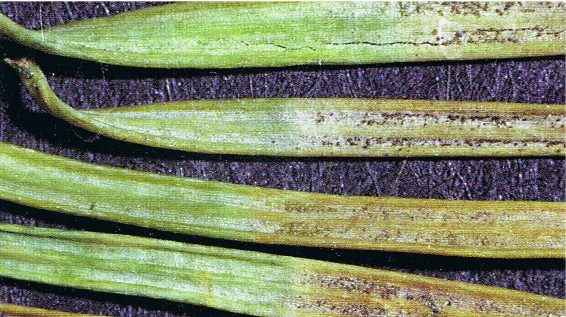PESTS AND DISEASES OF FORESTRY IN NEW ZEALAND
Rhizosphaera kalkhoffii and R. pini
Scion is the leading provider of forest-related knowledge in New Zealand
Formerly known as the Forest Research Institute, Scion has been a leader in research relating to forest health for over 50 years. The Rotorua-based Crown Research Institute continues to provide science that will protect all forests from damage caused by insect pests, pathogens and weeds. The information presented below arises from these research activities.
From Forest Pathology in New Zealand No. 13, Some minor fungi of conifers.
Based on I.A. Hood and C.J. Sandberg (1985)
Type of injury
Colonisers of needle tissues killed from other causes. Rarely infect living needles.
Diagnostic feature
Parallel rows of tiny (about 0.1 mm diameter), brown or black, spherical fruiting bodies coincident with the stomata on the surfaces of dead portions of conifer needles (Fig. 5).
On the needles of Pseudotsuga menziesii these fruiting bodies are usually brown, and can therefore be distinguished from those of Phaeocryptopus gaeumannii. Rhizosphaera kalkhoffii and R. pini can be separated only by use of the microscope.
Hosts
Rhizosphaera kalkhoffii: Abies grandis; Larix decidua; L. kampfaeri; Picea abies; P. sitchensis; Pinus jeffreyi; P. patula; P. ponderosa; P. radiata; Pseudotsuga menziesii; Sequoia sempervirens.
Rhizosphaera pini: Picea pungens; P. sitchensis; Pseudotsuga menziesii.
Other species of these genera might also be hosts.
Distribution
Throughout New Zealand.
Disease development
Rhizosphaera kalkhoffii and R. pini are almost always confined to dead needles or dead portions of living needles, but R. kalkhoffii occasionally infects bruised, green foliage. Spores have been found within fruiting bodies in nearly every month of the year, but the effects of environmental factors on needle colonisation have not been studied.

Fig. 5 - Fruiting bodies of Rhizosphaera kalkhoffii produced from stomata on damaged needles of Pseudotsuga menziesii.
Economic importance
Rhizosphaera kalkhoffii and R. pini are of little economic significance. They normally colonise only a few needles on otherwise healthy trees although there is one record of R. kalkhoffii as a possible needle-cast fungus on Picea abies. In 1971, trees at the edge of stands of Pseudotsuga menziesii throughout parts of Canterbury became extensively colonised by R. kalkhoffii, suggesting the outbreak of disease. However, needle damage was attributed primarily to windburn caused by a particular combination of warm, dry, north-westerly winds, and the problem has not recurred.
Rhizosphaera kalkhoffii is associated with needle-casting of spruces (Picea spp.) in Europe and North America, and pines (Pinus spp.) in Japan.
Control
Not considered necessary.
This information is intended for general interest only. It is not intended to be a substitute for specific specialist advice on any matter and should not be relied on for that purpose. Scion will not be liable for any direct, indirect, incidental, special, consequential or exemplary damages, loss of profits, or any other intangible losses that result from using the information provided on this site.
(Scion is the trading name of the New Zealand Forest Research Institute Limited.)

 Farm Forestry New Zealand
Farm Forestry New Zealand

